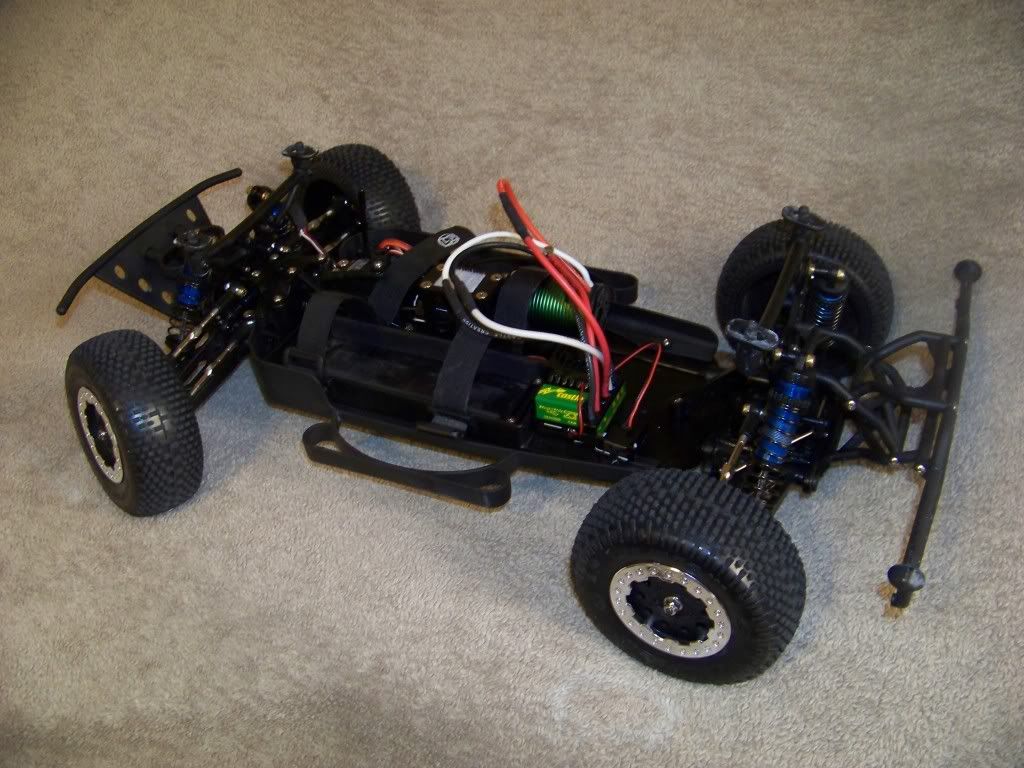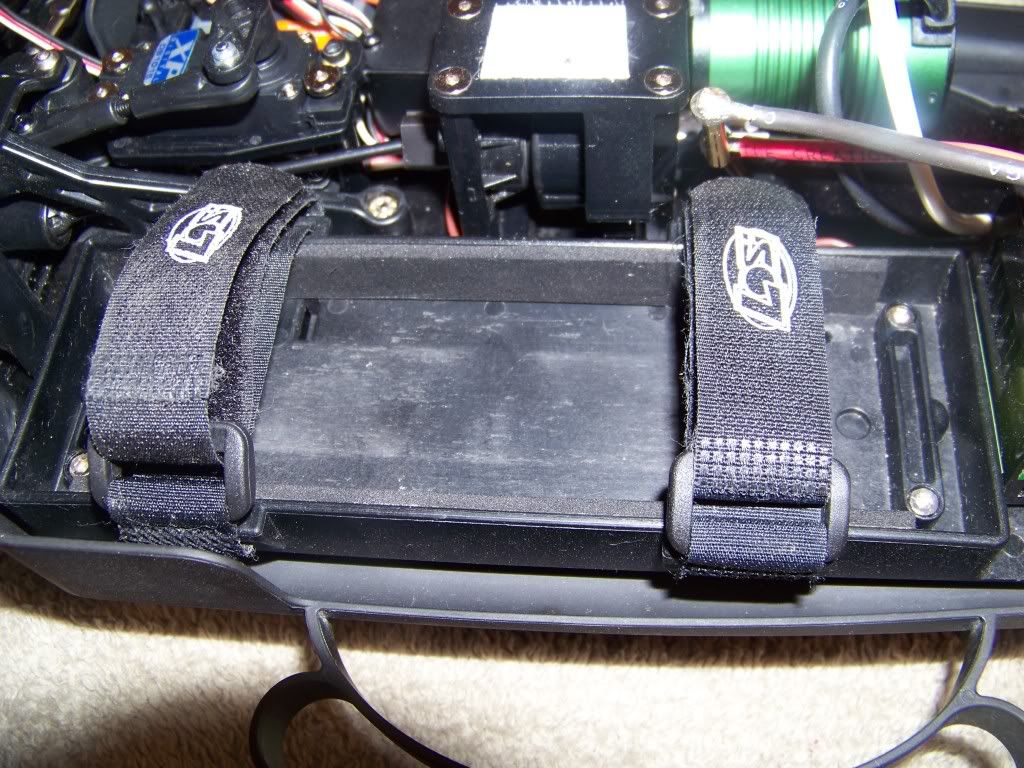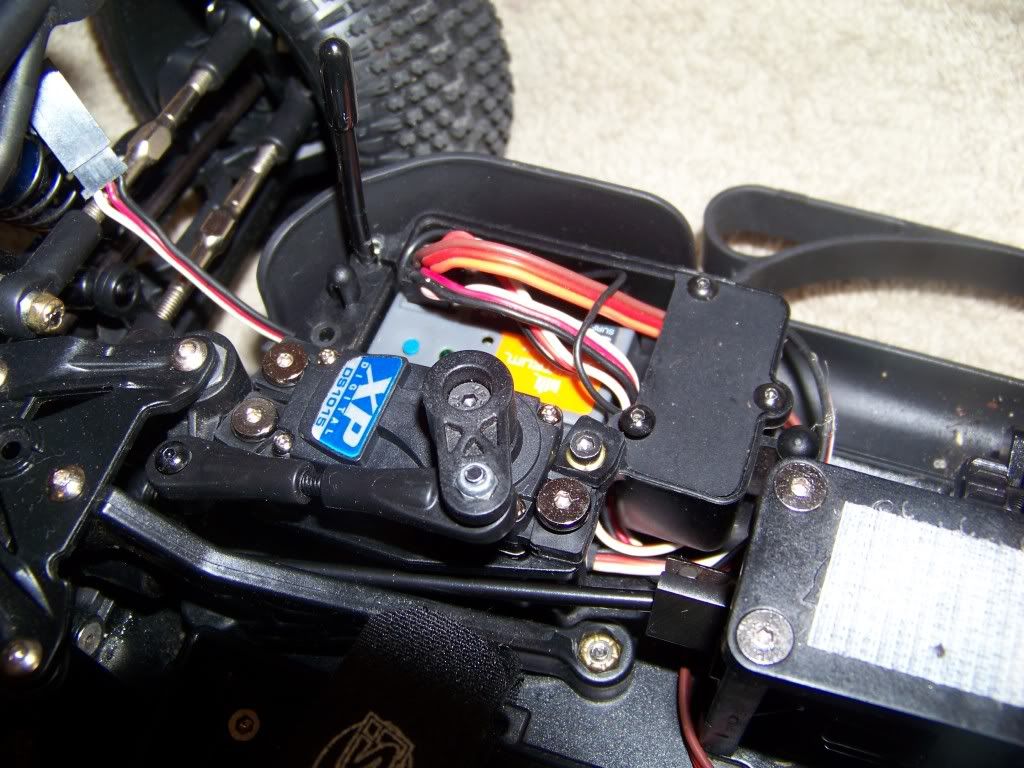The four wheel drive short course truck class has exploded in recent months. All of the major manufacturers have been scrambling to release their own version. Some were ground up new designs taking several months of R&D to complete and release. Others were based on already released vehicles. One such example is the TEN SCTE from Losi.

The Losi TEN SCTE (LOSB0127) is based on the Losi Ten-T, a 1/10 scale Nitro Truggy. Available as an ARR (Almost ready to run), the TEN SCTE is mostly assembled when you take it out of the box. You need to add an electric motor, ESC, high torque servo, and a radio system. Of course you also need to pick a decent battery. For my SCTE, I decided to go with Castle Creations Mamba Max Pro ESC, and Castle Creations Sidewinder SCT motor (model 1410 1 y) for a power system. I went with a Team Associated DS1015 servo. With the heavier four wheel drive short course trucks, you need a beefy servo to get around the corners. Most manufacturers recommend a servo with around 200 oz. of torque. It is also beneficial to find one with a decent speed. The Team Associated servo I chose is rated for 201.4 oz/ in. of torque, with a speed of .108 seconds. The speed is measured as the time it takes to travel 60 degrees. These are both at 6V.
In a typical short course truck, the motor is mounted perpendicular to a plate with one slotted hole used to adjust for proper mesh between the pinion and spur gears. While you have to obtain the same mesh on this truck, Losi put some thought into the way they wanted to accomplish it. The motor mount is actually quite ingenious. In the Ten SCTE, the motor is secured with two screws to a small plate, which then slides into a mount. There is one screw on this mount with which to adjust the pinion/spur mesh. It is a very clean setup, and makes adjusting mesh very easy. The truck comes standard with a 40T, mod 1 spur gear. This is a metric pitch, more commonly seen in 1/8 scale buggies. The spur gear is mounted directly to the center differential. The motor sits parallel with the center-line of the truck.

My initial reaction to the truck as I took it out of the box was how heavy duty everything seems. The tie rods and camber links are huge at 4mm. One of the nice features with these are that they have captured ends. This means they have an eyelet, and a screw goes through them to get fastened to the truck. On a lot of applications, they use ball cups that snap onto a ball which is threaded into the mounting location. These can pop off in a crash. Easy to fix, but one popping off can cost you a race. With a captured end, they won’t pop off ever. The wheels mount on a 12mm hex nut. This is a standard size for many applications, which means there are many choices already available for wheels.
The truck comes with beadlock style wheels, and Losi’s Eclipse Short course tire. Not sure how these are going to react yet to the track. I picked up a set of DE Racing wheels, and AKA Enduro tires. I picked the soft compound of the AKA Enduros because it is said as they heat up, they become softer. Some suggest that having the super soft compound might be too soft in the heat of summer.
The Losi Ten SCTE comes standard with 12mm threaded aluminum shocks. Being aluminum, they should prove to be very strong. Threaded shocks make it very easy to make adjustments trackside in between heats. Typically you have plastic inserts that the spring seats against. With plastic spacers, your adjustments are limited only to the sizes you have. Having the threaded shocks on the TEN SCTE, you’ll be able to set them at whatever increments are needed. (For more information on tuning shocks, see our Suspension Tuning basics article). To further aid in the handling department, Losi included adjustable sway bars, both front and rear. Sway bars serve as a way to tie the two sides of the suspension together. When cornering, they assist in limiting body roll, as well as keeping all four tires planted. Where the inside tires will want to lift off the ground with the momentum of the truck, the active force of the sway bars will keep them planted.


For a battery in my SCTE, I’ll be using a 2S 50C, 5000Mah Venom Lipo. The battery tray on the truck allows three positions for the battery. There are two small tabs that can be moved either front or back. If you have one tab in each the front and back of the tray, the battery is centered in the tray. If you remove the front tab, and move the rear tab forward, the battery will be more towards the front of the tray, putting more weight over the front wheels. This will aid in steering. If you remove the rear tab, and move the front tab back, the battery will be in the rear of the tray, and will aid in rear traction. To hold down the battery, Losi put in velcro straps. These straps are long enough to accommodate up to a 6S 5000 Mah Lipo.
The chassis on the Losi TEN SCTE is aluminum, and anodized black. It features rock guards at the leading edges. This will prevent rocks and dirt that are being kicked up by the front tires from directly impacting the electronics. Behind the rock guards, Losi incorporated a closed receiver box.

Both the receiver box and battery tray are removable from the chassis for ease of cleaning, as well as aiding in the installation of the receiver. Its kind of packed in that front right corner, what with the servo and receiver box tight in together. But, once they are installed it’s actually a very clean looking section.
Overall, I am impressed with the build quality of this truck out of the box. I’m very excited to get this truck on the track this week. I’ve driven it for a few minutes on the street, and it is a rocket. Stay tuned for my race review later this week.
Build Specs:
ESC – Castle Creations Mamba Max Pro
Motor- Castle Creations Sidewinder SCT 3800KV
Servo- Team Associated DS1015
Wheels- DE Racing wheels
Tires- AKA Enduro Tires
UPDATE AFTER RUNNING ON TRACK
I’ve had a few opportunities to run the SCTE on the track since this review. I can’t get over how much power that little 3800 4 Pole puts out. In the straights, I was just as fast as every other truck out there, including the ones running the big 550’s. Initially, I was having issues over the jumps with the truck wanting to nose dive. There is so much torque, that simply removing your finger from the trigger while in the air has the same effect as jabbing the breaks on a 2wd truck. Eventually I was able to find a balance. If I held the throttle over the jump just long enough, I could keep the node up, then release at the opportune time to land the truck flat. Its a fine line though, between releasing the trigger a hair late results in the truck “parachuting”. Parachuting refers to the effect the air plays under the large SCT body. Once the body catched the air underneath, the nose of the truck lifts and you lose a lot of speed. I found, however, that a strategically placed cutout on the body vitually eliminates the parachuting effect. Right at the back of the roof, where the body continues down to the rear, I cut a 3/4″ by 4″ hole. This allows air to escape from under the body while flying over a jump, thus preventing the “parachuting” effect.
Tomorrow we will be having a test and tune at Canalside Raceway where I’ll have an opportunity to face the SC10 4×4 for the first time. Should be a blast!



 May 7th, 2011
May 7th, 2011  Matt
Matt  Posted in
Posted in